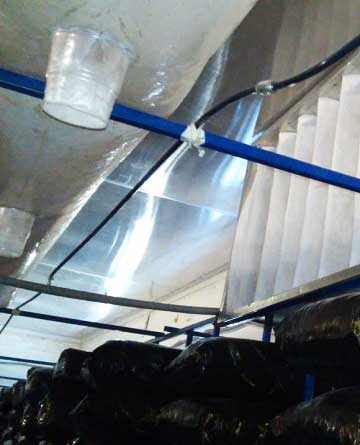
Table of Contents:
The room where oyster mushrooms grow is called differently in different countries. In addition to the term growing room, I know such names as cultivation chamber or growing chamber, cultivation tent and fruiting room.
Therefore, I will use some of these names, referring to the room for oyster mushrooms.
Let's consider how to make an air intake and exhaust in the growing room.
If the ventilation system in your growing room consists of a hole in the wall through which air comes in and an exhaust fan that pulls the air out, you can read about it in this article.
Mushrooms release CO₂ and moisture as they grow, and without proper airflow, these byproducts accumulate, leading to poor fruiting conditions. Ventilation serves two key functions:
1. Removing excess CO₂ and humidity – High CO₂ levels can cause elongated, deformed stems, while excessive moisture encourages contamination.
2. Maintaining fresh airflow – Consistent air movement ensures even distribution of temperature and humidity, creating a stable microclimate.
The necessary airflow depends on the amount of substrate in the grow room, not just air volume per hour.
A centrifugal fan (either a duct fan or snail fan) is used to exchange air. The fan size depends on the substrate load:
Airflow calculation – If all blocks fruit simultaneously (single-zone method), airflow should be 300 cubic meters per hour (approximately 175 CFM) per ton of substrate.
For mixed-age blocks, 180-220 cubic meters per hour (approximately 105–130 CFM) per ton is sufficient.

Air ducts distribute fresh air across the room.
Their size is calculated to maintain an airspeed of 4-5 m/s (13-16 ft/s) inside the ducts.
The central duct is the largest, while side ducts have a smaller diameter (as shown in the photo).
I created a ventilation guide based on the method described in this article.
It includes calculations for fan capacity, duct diameters, and other parameters, depending on the amount of substrate in your grow room.
You can find it here
Why use nozzles instead of just cutting holes?
• Nozzles create directed air jets, ensuring even airflow.
• They help maintain a consistent speed of 8-9 m/s (26-30 ft/s)
You can measure the airflow speed from the nozzles by placing an anemometer directly against the opening of the plastic cup (in the photo).

The distance between the nozzles-cups is from 0.45 cm to 80 cm.
Recirculation allows partial reuse of grow room air, reducing heating costs in winter and preventing sudden temperature or humidity fluctuations.
To prevent spore buildup in the system, a G3-class air filter is installed before the heat exchanger and fan.
Never heat the grow room directly with radiators, heat guns, or stoves. Instead, use a water-based air heater inside the ventilation system.
Exhaust Fan Placement and CO₂ Management
CO₂ Does Not "Sink" to the Floor – A Common Myth

Many growers believe that CO₂ accumulates at the bottom of the grow room.
But if ventilation works properly, this doesn't happen.
When the exhaust fan is installed near the ceiling (Location 2), the airflow from the nozzles hits the floor and rises between the mushroom blocks, picking up the CO₂ along the way.
The gas mixes with the moving air and is removed through the exhaust.
But if the exhaust is located near the floor (Location 1), the air blowing from above doesn't effectively pick up the CO₂ around the growing clusters.
On top of that, most of the airflow goes straight into the exhaust opening without properly flushing the space between the mushrooms.
Humidity should be controlled within the ventilation system, not directly in the grow room.
Ventilation must run continuously while mushrooms are growing.
Turning ventilation on/off with a timer is a mistake. This leads to microclimate fluctuations, affecting yield and mushroom quality.
The exhaust fan should always run unless the system is in 100% recirculation mode.
If you need help designing the ventilation system described in the article, please contact me for advice.
By following these principles, you can create an efficient and reliable ventilation system for oyster mushroom cultivation.
